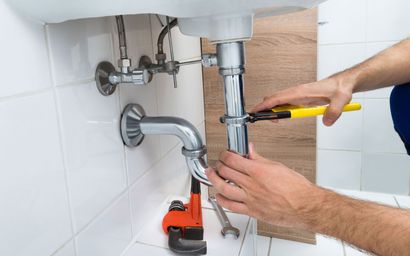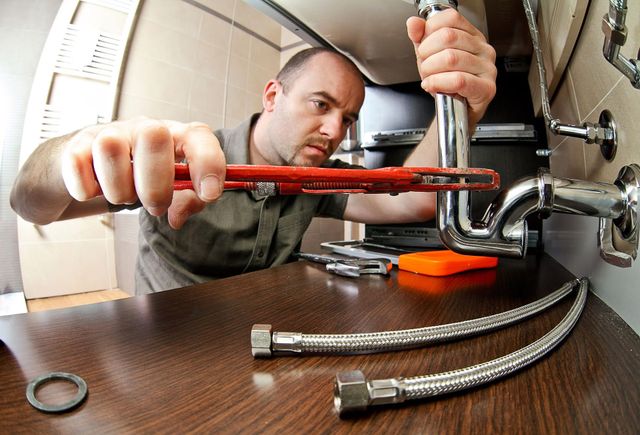Were you hunting for critical info about The Inner Workings of Your Home's Plumbing?

Comprehending exactly how your home's plumbing system works is essential for every homeowner. From supplying clean water for alcohol consumption, food preparation, and showering to securely getting rid of wastewater, a well-kept plumbing system is essential for your family's wellness and comfort. In this extensive overview, we'll discover the complex network that makes up your home's plumbing and offer suggestions on maintenance, upgrades, and handling usual concerns.
Intro
Your home's plumbing system is more than simply a network of pipelines; it's a complicated system that ensures you have access to tidy water and reliable wastewater elimination. Recognizing its elements and how they interact can aid you stop costly repairs and make certain every little thing runs smoothly.
Standard Parts of a Plumbing System
Pipes and Tubes
At the heart of your pipes system are the pipes and tubing that lug water throughout your home. These can be constructed from numerous materials such as copper, PVC, or PEX, each with its benefits in terms of sturdiness and cost-effectiveness.
Fixtures: Sinks, Toilets, Showers, and so on.
Components like sinks, toilets, showers, and bath tubs are where water is made use of in your house. Comprehending just how these fixtures connect to the pipes system assists in identifying problems and planning upgrades.
Shutoffs and Shut-off Factors
Valves regulate the circulation of water in your pipes system. Shut-off shutoffs are crucial during emergencies or when you require to make fixings, permitting you to isolate parts of the system without interfering with water circulation to the whole house.
Supply Of Water System
Key Water Line
The major water line links your home to the community water or a personal well. It's where water enters your home and is distributed to numerous fixtures.
Water Meter and Stress Regulatory Authority
The water meter measures your water usage, while a pressure regulatory authority makes sure that water flows at a secure stress throughout your home's pipes system, avoiding damages to pipes and fixtures.
Cold Water vs. Warm water Lines
Recognizing the difference between cold water lines, which supply water straight from the main, and warm water lines, which bring warmed water from the water heater, aids in fixing and planning for upgrades.
Drain System
Drain Piping and Traps
Drain pipelines carry wastewater far from sinks, showers, and commodes to the sewage system or septic tank. Traps stop sewage system gases from entering your home and additionally trap particles that can cause blockages.
Air flow Pipes
Ventilation pipelines permit air into the drain system, preventing suction that could slow down drain and trigger catches to vacant. Proper ventilation is necessary for keeping the stability of your pipes system.
Importance of Correct Drainage
Ensuring appropriate drain protects against backups and water damage. On a regular basis cleansing drains and maintaining traps can stop costly repair work and expand the life of your pipes system.
Water Heating Unit
Types of Water Heaters
Water heaters can be tankless or standard tank-style. Tankless heating systems warmth water on demand, while tanks keep heated water for instant usage.
Just How Water Heaters Connect to the Plumbing System
Recognizing just how hot water heater connect to both the cold water supply and warm water circulation lines assists in diagnosing concerns like inadequate hot water or leaks.
Upkeep Tips for Water Heaters
Consistently purging your hot water heater to get rid of sediment, examining the temperature setups, and checking for leaks can extend its life-span and enhance power effectiveness.
Typical Plumbing Issues
Leaks and Their Reasons
Leakages can happen because of maturing pipes, loosened installations, or high water stress. Attending to leaks promptly avoids water damages and mold development.
Clogs and Obstructions
Obstructions in drains pipes and toilets are commonly caused by flushing non-flushable things or an accumulation of oil and hair. Using drainpipe screens and bearing in mind what drops your drains can stop blockages.
Indicators of Plumbing Troubles to Look For
Low tide pressure, slow-moving drains, foul odors, or unusually high water costs are signs of possible pipes issues that should be dealt with without delay.
Pipes Maintenance Tips
Normal Evaluations and Checks
Arrange yearly plumbing inspections to catch concerns early. Seek indications of leakages, rust, or mineral buildup in faucets and showerheads.
Do It Yourself Maintenance Tasks
Easy jobs like cleaning tap aerators, looking for toilet leakages making use of dye tablets, or protecting revealed pipes in cold environments can protect against major pipes problems.
When to Call a Specialist Plumbing Technician
Know when a pipes issue needs expert expertise. Attempting complicated repair work without correct understanding can lead to even more damages and higher repair work costs.
Updating Your Pipes System
Factors for Upgrading
Upgrading to water-efficient components or changing old pipes can enhance water high quality, lower water bills, and enhance the worth of your home.
Modern Pipes Technologies and Their Benefits
Explore innovations like clever leakage detectors, water-saving toilets, and energy-efficient water heaters that can save money and minimize ecological effect.
Expense Factors To Consider and ROI
Compute the in advance prices versus lasting savings when taking into consideration pipes upgrades. Several upgrades spend for themselves with decreased utility costs and less fixings.
Environmental Effect and Conservation
Water-Saving Fixtures and Home Appliances
Mounting low-flow taps, showerheads, and commodes can significantly decrease water use without giving up efficiency.
Tips for Reducing Water Usage
Easy habits like repairing leakages without delay, taking shorter showers, and running complete tons of washing and recipes can preserve water and lower your utility expenses.
Eco-Friendly Plumbing Options
Think about lasting pipes products like bamboo for floor covering, which is durable and eco-friendly, or recycled glass for countertops.
Emergency Preparedness
Steps to Take Throughout a Pipes Emergency situation
Know where your shut-off shutoffs lie and exactly how to shut off the water system in case of a burst pipe or major leak.
Significance of Having Emergency Contacts Useful
Keep call info for local plumbings or emergency services readily available for fast feedback throughout a pipes dilemma.
DIY Emergency Fixes (When Applicable).
Momentary fixes like using duct tape to patch a dripping pipeline or positioning a pail under a leaking faucet can minimize damages up until a professional plumber gets here.
Final thought.
Understanding the makeup of your home's pipes system encourages you to preserve it successfully, saving money and time on repair services. By following routine maintenance regimens and staying informed concerning modern-day pipes technologies, you can ensure your plumbing system runs successfully for years to come.
HOW YOUR PLUMBING SYSTEM WORKS
Which Pipes Do What?
Blue lines = fresh water supply entering the building
Red lines = hot water supply entering the building
Grey lines = pipes carrying waste away from the building and venting pipes carrying gases away from the building (through the roof)
YOUR MAIN PLUMBING SYSTEMS
There are two main plumbing systems that support your home s basic plumbing needs one that brings clean water into your home, and one that sends dirty water away from your home. Connected to the toilet, bath, shower, and other faucets in your home, these two systems keep your water flowing in the right directions.
ACCESSING FRESH WATER
Fresh and clean water is brought into your home through the main water supply line . Filtered through one pipe, this water is pressured to flow into the various fixtures in your home at any given time.
This water can be sourced from a well located on your property, a pond or river (mostly cottages), or, as in most cases, from the city s municipal water treatment centre. However, it is important to note that water that is untreated, such as the water siphoned from ponds or rivers, may not be safe to drink. Personal water supplies always need to be treated for hardness and contaminants before consumed.
MUNICIPAL WATER SUPPLIES
Improve taste and odour
Remove sediment
Eliminate hardness
Reduce chlorine
COLD WATER SUPPLY VS. HOT WATER SUPPLY
Cold water flows into your home or building through the service line, which then distributes hot or cold water to your fixtures. This line is most commonly run through a central column that runs floor to floor. Hot water runs in short and straight pipes as the longer the pipeline, the more heat that will be lost in the transfer. Having shorter pipes also allows residents to access hot water more quickly.
WASTE WATER SYSTEM
Your wastewater system is divided into two parts pipes that send wastewater away from your home and venting pipes that send sewer gas away from your home. Sewage water travels through pipes that flush the water and waste towards local sewers that are operated and managed by your city or town. Most sewer systems rely on gravity to move the wastewater to where it needs to go.
The further away from your toilet or sink, the larger wastewater pipes become. This allows for waste to be disposed of from various parts of your home or business at once without pipe blockages. The angle and flow of these pipes are also essential for keeping your waste pipes clear of build up.
https://harrisplumbing.ca/how-your-home-plumbing-system-works/

HOW YOUR PLUMBING SYSTEM WORKS
Which Pipes Do What?
YOUR MAIN PLUMBING SYSTEMS
There are two main plumbing systems that support your home s basic plumbing needs one that brings clean water into your home, and one that sends dirty water away from your home. Connected to the toilet, bath, shower, and other faucets in your home, these two systems keep your water flowing in the right directions.
ACCESSING FRESH WATER
Fresh and clean water is brought into your home through the main water supply line . Filtered through one pipe, this water is pressured to flow into the various fixtures in your home at any given time.
This water can be sourced from a well located on your property, a pond or river (mostly cottages), or, as in most cases, from the city s municipal water treatment centre. However, it is important to note that water that is untreated, such as the water siphoned from ponds or rivers, may not be safe to drink. Personal water supplies always need to be treated for hardness and contaminants before consumed.
MUNICIPAL WATER SUPPLIES
COLD WATER SUPPLY VS. HOT WATER SUPPLY
Cold water flows into your home or building through the service line, which then distributes hot or cold water to your fixtures. This line is most commonly run through a central column that runs floor to floor. Hot water runs in short and straight pipes as the longer the pipeline, the more heat that will be lost in the transfer. Having shorter pipes also allows residents to access hot water more quickly.
WASTE WATER SYSTEM
Your wastewater system is divided into two parts pipes that send wastewater away from your home and venting pipes that send sewer gas away from your home. Sewage water travels through pipes that flush the water and waste towards local sewers that are operated and managed by your city or town. Most sewer systems rely on gravity to move the wastewater to where it needs to go.
The further away from your toilet or sink, the larger wastewater pipes become. This allows for waste to be disposed of from various parts of your home or business at once without pipe blockages. The angle and flow of these pipes are also essential for keeping your waste pipes clear of build up.
https://harrisplumbing.ca/how-your-home-plumbing-system-works/
We were shown that article about Plumbing Installation 101: All You Need to Know through a good friend on another site. Appreciated our blog entry? Please share it. Let somebody else find it. Many thanks for taking the time to read it.
Call Today